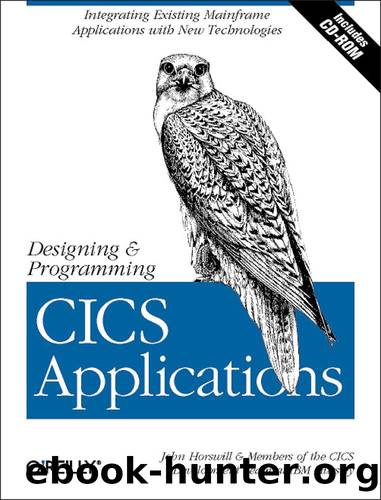Designing and Programming CICS Applications by John Horswill & Members of the CICS Development Team at IBM Hursley

Author:John Horswill & Members of the CICS Development Team at IBM Hursley [John Horswill]
Language: eng
Format: epub
Tags: COMPUTERS / Hardware / Mainframes & Minicomputers
ISBN: 9781449313036
Publisher: O'Reilly Media
Published: 2011-07-12T16:00:00+00:00
What Is BMS and What Does It Do?
BMS simplifies your programming job, keeping your code largely independent of any changes in your network of terminals and of any changes in the terminal types. It’s probably easiest to define what BMS does by examining the menu screen that is part of our initial program; see Figure 11-1. It all looks quite straightforward, even if there is a lot of detail.
Figure 11-1. The menu screen
You define this screen with BMS macros, which are a form of System/390 Assembler language. When you’ve defined the whole map, put some job control language (JCL) around it and assemble it. You assemble it twice, in fact. One of the assemblies produces the physical map. This gets stored in one of the execution-time libraries, just like a program, and CICS uses it when it executes a program using this particular screen. However, this physical map does not contain any executable code—the physical map is stored in a program library to enable it to be loaded and unloaded like code.
The physical map contains the information BMS needs to:
Build the screen, with all the titles and labels in their proper places and all the proper attributes for the various fields.
Download
This site does not store any files on its server. We only index and link to content provided by other sites. Please contact the content providers to delete copyright contents if any and email us, we'll remove relevant links or contents immediately.
Windows Terminal Tips, Tricks, and Productivity Hacks by Will Fuqua(1565)
Augmented Reality with Unity AR Foundation by Jonathan Linowes(1329)
Sketching User Experiences by Buxton Bill(686)
Object-Role Modeling Fundamentals: A Practical Guide to Data Modeling with ORM by Terry Halpin(660)
Beginning AutoCAD 2020 Exercise Workbook by Cheryl R. Shrock(610)
Windows 10: The Missing Manual by Pogue David(596)
You Donât Know JS: Up & Going by Kyle Simpson(595)
Adobe InDesign for Absolute Beginner: Tips and Techniques to Creating Professional Books and Magazines for Online and Desktop Publishing using InDesign by Scott Walter & Scott Walter(581)
SketchUp For Dummies by Bill Fane & Mark Harrison & Josh Reilly(573)
AI 2041: Ten Visions for Our Future by Kai-Fu Lee & Chen Qiufan(559)
The Rainbow Stack: A Casual Guide to UX Design by Jawara Joseph(554)
100 Principles of Game Design by unknow(540)
Research Methods in Human-Computer Interaction by unknow(538)
Advanced Game Design by Michael Sellers(536)
TensorFlow 2.0 Computer Vision Cookbook by Jesus Martinez(512)
Hands-On Data Visualization by Jack Dougherty(498)
Photoshop Elements 12 All-in-One For Dummies by Barbara Obermeier & Ted Padova(496)
Mastering InDesign Templates by Murphy Monica & Knorr Mancini Margot(492)
Connected, Intelligent, Automated: The Definitive Guide to Digital Transformation and Quality 4.0 by Radziwill N. M(470)
